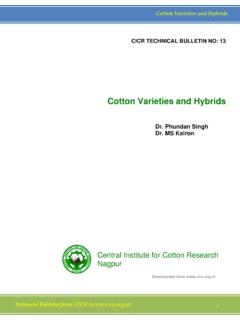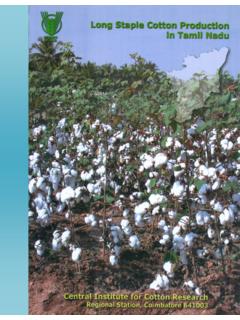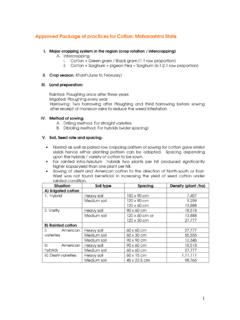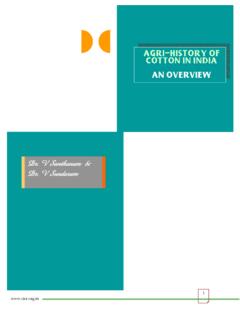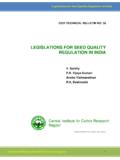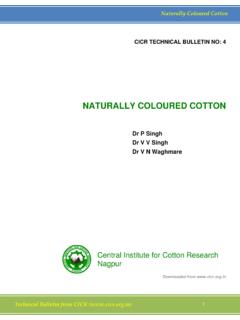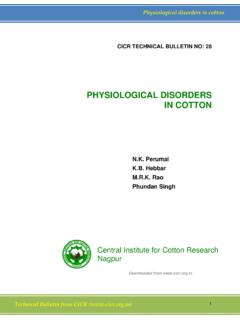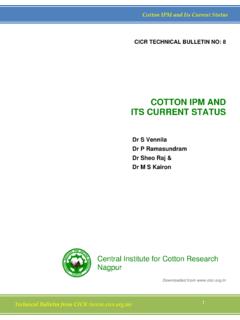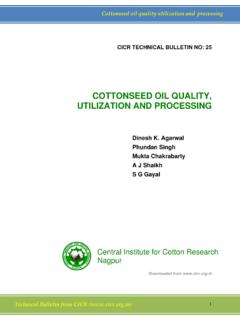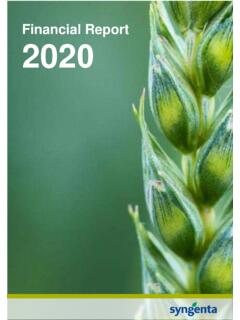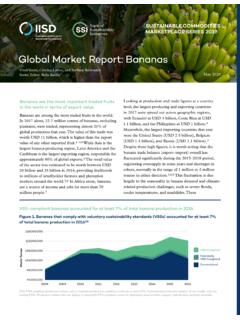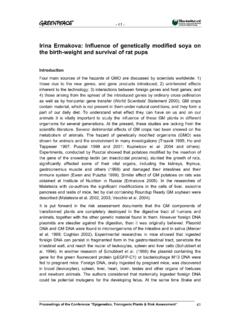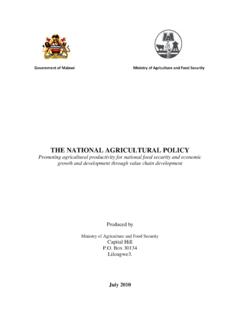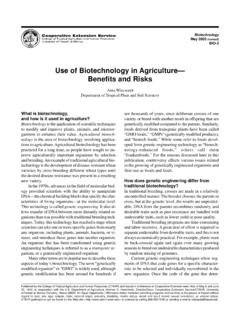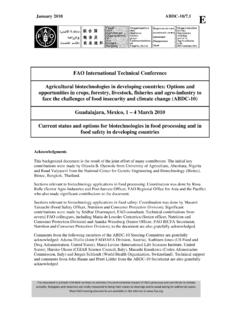Transcription of TRANSGENIC BT COTTON
1 Technical Bulletin from CICR ( ) 1 TRANSGENIC Bt COTTON CICR TECHNICAL BULLETIN NO: 22 TRANSGENIC Bt COTTON Dr CD Mayee Dr P Singh Dr AB Dongre Dr MRK Rao Dr Sheo Raj Downloaded from Central Institute for COTTON Research Nagpur Technical Bulletin from CICR ( ) 2 TRANSGENIC Bt COTTON TRANSGENIC Bt COTTON 1. Introduction COTTON is one of the major fibre crops of global significance. It is cultivated in tropical and sub-tropical regions of more than eighty countries of world occupying nearly 33 m ha with an annual production of 19 to 20 million tones of bales. China, , India, Pakistan, Uzbekistan, Australia, Brazil, Greece, Argentina and Egypt are major COTTON producing countries. These countries contribute nearly 85% of the global COTTON production. In India, COTTON is being cultivated in m ha and stands first in acreage. The crop is grown in varied agro-climatic situation across nine major states viz.
2 Maharashtra, Gujarat, Madhya Pradesh, Punjab, Haryana, Rajasthan, Andhra Pradesh, Karnataka and Tamil Nadu. The crop is also grown on small area in Orissia, Assam, and West Bengal. Nearly 60 million people are engaged in COTTON production, marketing and processing. The textile industry which utilizes the COTTON provides employment to about 16% of the total workforce. COTTON in its various forms also serves as raw material for more than 25 industries. The decision of the Genetic Engineering Approval committee (GEAC) of Government of India clearing the release of Bt COTTON for commercial cultivation during 2002-2003 crop season, is considered as one of the major milestones in the history of COTTON improvement in India. Incidentally, COTTON happens to be the first crop to receive environment clearance as GMO in Indian Agriculture, and thus has received maximum attention from planners, scientists, social workers, media, farmers and general public.
3 With liberalization of world trade following WTO formation, quality and price competitiveness have become the buzz words not only for export performance but also for domestic use. India made significant strides in productivity since independence. The country was producing only m bales of short and medium staple COTTON from million ha (with production of 88 kg lint / ha). With two major technological interventions viz. introduction of hybrid technology in early seventies and molecules in early eighties, productivity rose to 300 kg lint/ha. However, the protection technology has been misused and started showing negative impact, thus stagnating yields for the last 5-6 years. Today, productivity of Indian cottons is lowest in the world. In contrast, the major COTTON producing countries have productivity 3 to 5 times higher. There are many reasons of low productivity of COTTON in India.
4 Besides dependency on 70% COTTON production on vagaries on monsoon, diverse ecological and soil conditions, constant threat from pests and diseases is considered a major biological challenge to successful COTTON productivity. Amongst the biotic stress factor, bollworms are by far the most serious pests of COTTON and alternative controlling strategies, such as Bt COTTON is considered a welcome technological step. 2. Why Bt COTTON ? In India, 162 species of insect pests attack different stages of COTTON . Of these, about a dozen are major and half of them are key production constraints necessitating management interventions in the crop ecosystem. The sucking pest complex comprising of aphids, jassids, thrips and whitefly are widespread and fairly serious. However, their damage can be efficiently contained by the existing practices of cultural, chemical, biological and host resistance means.
5 The bollworms are most important tissue feeders and highly damaging. Three types of bollworms viz. American bollworm (Helicoverpa armigera), Pink bollworm (Pectionphora gossypiella) and Spotted bollworm (Earias vitella), normally referred as bollworm complex are by far the most damaging and loss inducing pests of COTTON . Amongst them, Helicoverpa emerged as a key pest all over the country causing as high as 80% losses in COTTON . Technical Bulletin from CICR ( ) 3 TRANSGENIC Bt COTTON The epidemic witnessed in Rajasthan, Haryana, Punjab during 2001-2002 season is estimated to have reduced the yield of COTTON in North Zone of India by 50%. The frequent and regular crop failures in the last 15 years have been attributed to bollworms particularly Helicoverpa armigera. In India, an estimated billion to value of pesticides are used in agriculture (Agrolook, 2001), with billion worth on COTTON alone.
6 Bollworm control alone takes a heavy amount consting nearly billion and accounting for one third of current pesticide sales (Gupta 2001). Although, there has been some 10% reduction in pesticide consumption in COTTON over the last 7 years, the crop with its only 5% area consumers the highest amount of pesticides (Table-1) Table-1: Highly skewed pattern of pesticide use Crop Area(%) in India Pesticide used in India (%) Current pesticides used in world (%) 1995 2001 Rice 24 COTTON 05 Fruits + Vegetables 13 Oilseeds 10 Although a wide variety of products are used to minimize the pest damage including bollworms, there are currently new serious problems such as resistance to pesticides, resurgence of secondary pests, environmental contamination due to indiscriminate use and unspecific.
7 Spurious product dumping in the market. To combat these problems, integrated pest management (IPM) with greater emhasis on biological control has been recommended in the absence of sound host resistance to bollworm. However, IPM requires training, demonstrations, making available biocontrol agents, participatory monitoring of pest incidence and community system approach at village level. Lot of efforts have been made for alternative strategies of bollworm management and various non-pesticidal (NPM), restricted pesticidal (IRM) and IPM techniques have been formulated, tested and demonstrated. These are slowly gaining acceptance but so far successes have been restricted and dissemination is slow. TRANSGENIC Bt COTTON , which evokes inbuilt resistance in the host is gaining wider adaptability as a means of avoidance of losses due to bollworm because the technology operates at seed level dissemination and find quick favour among the users.
8 Therefore, Bt COTTON has already proved useful in countries where it has been introduced earlier. In Indian context also, it is expected to give a wider base to all other protection strategies in COTTON . 3. What is Bt? The Bt is a short form of ubiquitous soil bacterioum Bacillus thuringiensis. This bacterium is gram positive and spore forming that forms parasporal crystals during stationary phase of its growth cycle. The synthesized crystalline proteins called endotoxins are highly toxic to certain insects. They kill the insect by acting on the epithelium tissues of midgut of caterpillars. These protein often appear microscopically as distinctly shaped crystals and constitute about 20-30% of dry weight of sporulated cultures. These proteins are characterized by their insecticidal activity and are therefore grouped into four classes Lepidoptera-specific (Cry I), Lepidoptera and Diptera-specific (Cry II), Coleoptera-specific (Cry III) and Diptera-specific (Cry IV).
9 Different strains of Bt produce more than 25 different but related insecticidal crystal proteins (ICPs). These are toxic to larvae of different insects including disease vectors and many agricultural pests. COTTON bollworms belong to the order Lepidoptera and therefore are sensitive to Bt Cry I and Cry Technical Bulletin from CICR ( ) 4 TRANSGENIC Bt COTTON II proteins, which are specific to them. Other beneficial insects are unaffected by these proteins. The gene bank data base of Bacillus Genetic Stock Centre (BCSC) have given a list of Cry(Crystal), Cyt(Cytolytic) and Vip genes either synthetic or modified versions from about 22 classes of Cry including 126 Cry genes have been registered along with a Crt gene and 3 Vip (Vegetative insecticidal protein) genes. But popularly and effectively utilized are Cry 1 Ac, Cry 1 Ab in different crops. 4. What is Bt COTTON ? A genotype or individual which is developed by the techniques of genetic engineering is referred to as TRANSGENIC .
10 In other words, genetically engineered organisms are called transgenics. A TRANSGENIC may be a plant, an animal or a microbe. TRANSGENIC plants contain foreign gene or genetically modified gene of the same species. The foreign gene may be from a distantly related species, closely related species or unrelated species or from micro-organisms such as fungi, bacteria and viruses. Bt COTTON refers to TRANSGENIC COTTON which contains endotoxin protein inducing gene from soil bacterium Bacillus thuringiensis. The first TRANSGENIC plant was developed in 1983 in tobacco (Fraley ) in In COTTON , the first TRANSGENIC plant was developed in 1987 in by Monsanto, Delta and Pine companies (Benedict and Altman, 2001).Later on, the research work on development of TRANSGENIC was intensified all over the globe and several TRANSGENIC plants were developed. The TRANSGENIC COTTON is of two types viz.
